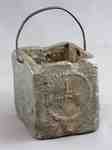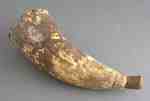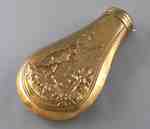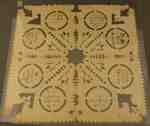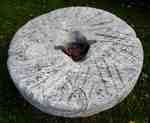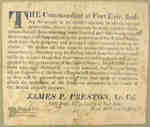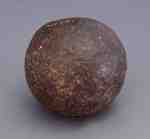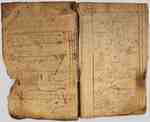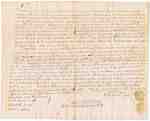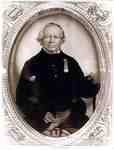Results
- A lead bucket and metal ladle that are believed by some to have been used for making bullets. The ladle has a copper scoop and measures 35 cm long with a hook on the end. The bucket, with a metal hanA lead bucket and metal ladle that are believed by some to …
- A hand-made powder horn, dated approximately 1800, that is believed to have existed since 1790. Both the flask and the stopper are made wood. For more information, read “‘Scruples of Conscience’: TheA hand-made powder horn, dated approximately 1800, that is believed to have …
- This large copper powder flask has a brass rim and spout at the top. Below the spout is marked "Dixon & Sons", the Manufacturer. The spout is marked: "DRAMS 4 1/2 4 1/2 4 3 3/4 3 1/2. Below the spoutThis large copper powder flask has a brass rim and spout at …
- A small copper flask that was presumably used for gun powder. There is a brass rim at the opening and a metal lever to open it. The design on the face is the same on both sides: Trees, a hunter and aA small copper flask that was presumably used for gun powder. There …
- A marriage certificate between Peter Neff and Maria Durrin. Clockwise starting from top right: Peter Neff a son of Abraham Neff. Bottom Right: was born the 23 October, 1780 in Yorck County, PennsylvaA marriage certificate between Peter Neff and Maria Durrin. Clockwise starting from …
- A mill stone from the Zavitz Mill located near the Eagle Marsh Drain (western end of Tennessee Avenue and Lakeshore Road in Port Colborne). The Zavitz Mill was one of the first mills in the southernA mill stone from the Zavitz Mill located near the Eagle Marsh …
- An original hand-written certificate dated August 31, 1812 declaring that John Graybiel of the Township of Wainfleet, County of Lincoln was a "manonist" and a son of a "Manonist" (meaning a MennoniteAn original hand-written certificate dated August 31, 1812 declaring that John Graybiel …
- Some names and dates have been removed from the additional note for privacy purposes.Some names and dates have been removed from the additional note for …
- This set of four cannonballs were found at Gravelly Bay in Port Colborne. It is believed that the cannonballs were found here because of their proximity to Zavitz Mill. During the war, the mill wouldThis set of four cannonballs were found at Gravelly Bay in Port …
- Cannonball that was found at the south end of Elm Street, near the lake, in Port Colborne. It is believed that military stores and munitions were often kept in the Sugar Loaf area and would be quicklCannonball that was found at the south end of Elm Street, near …
- Two cannonballs, one smaller and lopsided was found in a backyard on Catharine Street in Port Colborne and the other larger one was found elsewhere in the city. It is believed that military stores anTwo cannonballs, one smaller and lopsided was found in a backyard on …
- These five musket balls were found on Nickel beach at a home on Lakeshore Road East, Port Colborne Ontario. It is believed that during the War of 1812 many military stores and munitions were secretedThese five musket balls were found on Nickel beach at a home …
- An oil painting of Gravelly Bay and Sugarloaf Hill in Port Colborne. It is most likely a view taken from near Tennessee Avenue and Steele Street. The War of 1812 Veteran "Big John Steele", John SteelAn oil painting of Gravelly Bay and Sugarloaf Hill in Port Colborne. …
- The Ledger is indexed by account and not surnames as there are several names on each account due to bartering back and forth. Also, the page number in the index refers to the ledger's own page numberThe Ledger is indexed by account and not surnames as there are …
- The word ‘To’ in the Ledger refers to the goods which are purchased by the settlers and the word ‘By’ refers to the method of payment by the settler. The numbers in the right-hand columns refer to thThe word ‘To’ in the Ledger refers to the goods which are …
- A photo of Abraham P. Neff (December 7, 1802- December 16, 1874) wearing traditional Mennonite clothing. He was 10 years old when Michael Graybiel made the bellows for his father Peter Neff in 1812 tA photo of Abraham P. Neff (December 7, 1802- December 16, 1874) …
- A transcription of a letter written by James Fortier, the Port Colborne Lighthouse keeper, to the Honourable Jean Chabot regarding a salary adjustment. The original letter is currently unavailable. IA transcription of a letter written by James Fortier, the Port Colborne …
- A deed between Isaac and Abraham Laing and William Haun of the Township of Humberstone for Lot 9, Front Concession of the Township of Humberstone for 37 pounds, 10 shillings.A deed between Isaac and Abraham Laing and William Haun of the …
- A copy of an original photo of James Fortier (April 10, 1792- January 11, 1865) wearing a medal that was awarded in 1849 for his participation at the Battle of Fort Detroit under Major General Sir IsA copy of an original photo of James Fortier (April 10, 1792- …
- A letter written by James Fortier who was the Port Colborne Lighthouse keeper after his War of 1812 Service. He had participated at the Battle of Fort Detroit under Major General Sir Isaac Brock forA letter written by James Fortier who was the Port Colborne Lighthouse …






